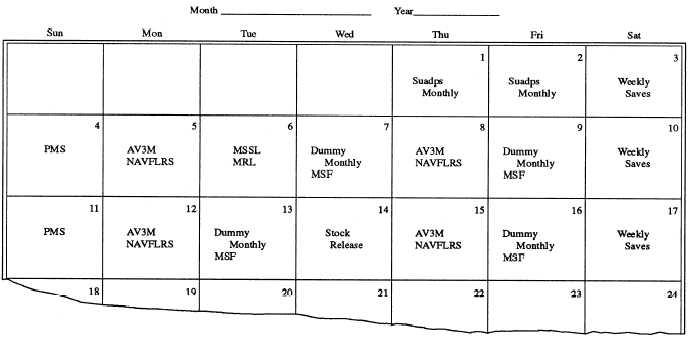job can continue. An unreadable tape or disk file may
have to be recreated. Errors in SCL statements in the
job stream may have to be corrected. The most serious
delays usually result from abnormally terminated jobs
and hardware failures. Regardless of what the situation
may be, you must be prepared to readjust schedules as
quickly as possible with a minimum of disruption.
PRODUCTION SCHEDULING
The AIS facility is tasked with the responsibility of
providing computer support to the command. This
includes support to medical/dental, supply,
administration, financial, and maintenance. Each of
these areas will have a subsystem coordinator assigned
to work with you on monthly schedule requirements
and on processing problems. You will also prepare
daily workload schedules.
MONTHLY PRODUCTION SCHEDULE
DEVELOPMENT
As the AIS manager, you will be responsible for
developing and distributing a monthly AIS operations
schedule. You have used monthly schedules, but you
may never have given much thought as to what it takes
to develop one.
To develop the monthly schedule, you must know
the requirements of all the application systems/jobs to
be run during the month. Many production jobs are run
on a cyclic basis—daily; Monday, Wednesday, and
Friday; weekly; monthly; quarterly; semiannually; or
annually. Be sure time is included for testing, planned
maintenance, file maintenance, and backup procedures.
For systems with online users, be sure to provide ample
capacity and time.
Schedule Review
Once you have developed the monthly schedule,
you must ensure that the schedule is adequate and meets
the requirements. To do this, you will see that the
proposed monthly production schedule is distributed to
the appropriate subsystem coordinators for their
review. Before the end of the current month, the
subsystem coordinators are to return the monthly
schedule with their concurrences or changes and
recommendations back to you for screening. You will
screen it to ensure they have not overscheduled any day,
and that there will be enough time for system backups
and planned maintenance. The screening process
should include a review by the production control
coordinator, who looks for any specific input/output
requirements. For example, special forms may have to
be ordered. This must be done early enough to have the
forms when the job is to be run. After screening the
changes and recommendations and making any
adjustments needed, have a smooth copy of the
schedule prepared and distributed to all subsystem
coordinators and the department head before the
beginning of the month to which the schedule applies.
Figure 1-6 is an example of part of a monthly production
schedule.
Figure 1-6.—Part of a monthly production schedule..
1-17

